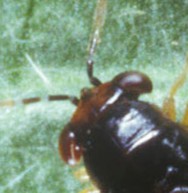 There are over twenty five species of bug-eyed bugs in North America some of which live coast to coast in the US. They are tiny but very abundant and considered highly valuable natural enemies of over 75 agricultural pests of turf, ornamental, and agricultural plants. Big-eyed bugs are generalist predators but occasionally eat plant material although usually not in sufficient quantity to damage the plant. Their diet include many different insect eggs, spider mites, aphids, pink bollworm, cabbage worms, cabbage loopers, cinch bugs, caterpillars, flea beetles, leafhoppers, thrips, corn earworms, and whiteflies.
There are over twenty five species of bug-eyed bugs in North America some of which live coast to coast in the US. They are tiny but very abundant and considered highly valuable natural enemies of over 75 agricultural pests of turf, ornamental, and agricultural plants. Big-eyed bugs are generalist predators but occasionally eat plant material although usually not in sufficient quantity to damage the plant. Their diet include many different insect eggs, spider mites, aphids, pink bollworm, cabbage worms, cabbage loopers, cinch bugs, caterpillars, flea beetles, leafhoppers, thrips, corn earworms, and whiteflies.
Adult big-eyed bugs are 1/6th to 1/4 inch long and have broad heads with wide-set bulging eyes, stout antennae, and clear overlapping wings that rest on their back. They are brown, yellow, black or gray and have flexible, piercing, sucking mouthparts that tuck under the head when not feeding. Females lay their pale oblong eggs on leaves or soil near prey to ensure a food supply for their young. The nymphs that hatch look similar to the adults but are smaller and lack wings. They undergo incomplete metamorphosis with 5 nymphal instars and mature into adults in about thirty days.Big-eyed bugs have multiple generations every year and over winter as adults with females beginning their egg laying in spring. A single female can produce up to three hundred eggs in her life time.
Unfortunately big-eyed bugs look very similar to some garden pests: chinch bugs ( Blissus spp.), false chinch bugs ( Nysius spp.), and pamera bugs (Neopamera spp.). It is important to distinguish between these bugs and the big-eyed bug before using pesticides in order to avoid killing beneficial big-eyed bug. Distinguished the bugs is very difficult,however, because of the small size of the insects and the subtlety of the differences. Expert help from the local Extension Office would be helpful.
To encourage big-eyed bugs, plant a garden with as much diversity as posible so as to provide cover, hiding areas, and places for over-wintering. Although big-eyed bugs are predators the adults will eat nectar and sap when prey are scarce or unavailable. Flowering plants such as boltonia, cosmos, laceflower, sunflowers, marigold (Tagetes tenuifolia), goldenrod, and sweet alyssum are good choice for the ornamental garden, caraway, fennel, spearmint, and angelica for the herb garden, and clover and alfalfa as a cover crop.